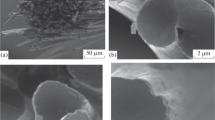Abstract
Two technologies of metallization of carbon ribbons in vacuum deposition and magnetron sputtering setups are considered. Titanium is used as a metallic coating. Carbon fiber reinforced plastic samples with a coupling agent based on aminopropyl triethoxysilane are prepared for comparison. The coupling agent is also applied using the following two technologies: in the first technology, it is applied onto a ribbon and is then dried; in the second technology, it is introduced into the composition of a binder. A LUP carbon ribbon and an epoxy binder are used for investigations. The carbon fiber reinforced plastics for all technologies under study are prepared using vacuum infusion. The increase in the interlayer shear strength is found to be maximal for the metallization of the carbon on a Bulat-6 setup.
Similar content being viewed by others
REFERENCES
V. A. Nelyub, A. S. Borodulin, L. P. Kobets, and G. V. Malysheva, “A study of structure formation in a binder depending on the surface microrelief of carbon fiber,” Polym. Sci., Ser. D 9 (3), 286–289 (2016).
N. I. Baurova, “Influence of nanostructured defects in carbon fibers and ribbons on sensor properties,” Polym. Sci., Ser. D 4 (3), 242–245 (2011).
N. I. Baurova and V. A. Zorin, Application of Polymer Composite Materials in the Production and Repair of Machines: Tutorial (MADI, Moscow, 2016).
T. A. Guzeva, “Curing of polymer binders using the energy of ultrahigh-frequency electromagnetic oscillations,” Klei. Germetiki. Tekhnologii, No. 8, 30–32 (2014).
I. A. Buyanov and D. S. Vdovin, “Development of a method for designing and technology of broaching preforms for producing carbon fiber reinforced plastics,” Klei. Germetiki. Tekhnologii, No. 10, 22–24 (2016).
V. A. Nelyub, A. S. Borodulin, L. P. Kobets, and G. V. Malysheva, “Capillary hydrodynamics of oligomer binders,” Polym. Sci., Ser. D 7 (4), 322–325 (2016).
V. M. Kuznetsov and G. E. Nekhoroshikh, “Application of carbon fiber reinforced plastics for the production of high-pressure toroidal vessels,” in All Materials. Encyclopedic Handbook (2015), Vol. 2, pp. 32–36.
N. I. Baurova and A. Y. Sergeev, “Structural studies of fracture patterns in adhesive joints after pullout testing,” Polym. Sci., Ser. D 7 (4), 298–302 (2014).
O. V. Tatarnikov, “Three-level designing of space-reinforcing composite structures,” in All Materials. Encyclopedic Handbook (2015), Vol. 7, pp. 21–26.
T. Yu. Tsibizova and T. A. Guzeav, “Automatic control systems for the technological processes of curing the products made of polymer composite materials,” Klei. Germetiki. Tekhnologii, No. 5, 35–40 (2015).
V. A. Nelyub, “Estimation of the adhesion interaction between a carbon fiber and an epoxy binder,” Klei. Germetiki. Tekhnologii, No. 7, 20–22 (2014).
S. L. Bazhenov, A. A. Berlin, A. A. Kul’kov, and V. G. Oshmyan, Polymer Composite Materials (Izd. Dom Intellekt, Moscow, 2010).
M. A. Gorodetskii, E. S. Tepishkina, and P. I. Chirva, “Typical problems in choosing auxiliary materials for the infusion technologies of formation of articles made of glass reinforced plastics,” in All Materials. Encyclopedic Handbook (2017), Vol. 4, pp. 60–65.
I. A. Buyanov, “Effect of the technology of broaching of carbon fabric on the properties of carbon fiber reinforced plastics,” Tekhn. Metallov, No. 8, 33–37 (2017).
ACKNOWLEDGMENTS
This work was performed in terms of the project Scientific Investigations for Developing Composites with a Controlled-Chaos Structure and Their Application in High-Tech Production (project no. 11.7291.2017/BCh).
Author information
Authors and Affiliations
Corresponding author
Additional information
Translated by K. Shakhlevich
Rights and permissions
About this article
Cite this article
Nelyub, V.A. Technologies of Metallization of Carbon Fabric and the Properties of the Related Carbon Fiber Reinforced Plastics. Russ. Metall. 2018, 1199–1201 (2018). https://doi.org/10.1134/S0036029518130189
Received:
Published:
Issue Date:
DOI: https://doi.org/10.1134/S0036029518130189




